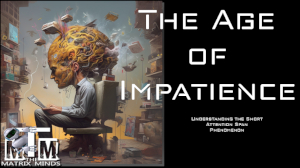 In today’s fast-paced digital era, it is no secret that people’s attention spans have become increasingly shorter. The rise of smartphones, social media, and constant connectivity has ushered in an age of distraction, where capturing and maintaining someone’s focus has become a significant challenge. In this article, we delve into the factors contributing to the short attention span phenomenon and explore its impact on various aspects of modern life.
In today’s fast-paced digital era, it is no secret that people’s attention spans have become increasingly shorter. The rise of smartphones, social media, and constant connectivity has ushered in an age of distraction, where capturing and maintaining someone’s focus has become a significant challenge. In this article, we delve into the factors contributing to the short attention span phenomenon and explore its impact on various aspects of modern life.
- Information Overload
The abundance of information available at our fingertips has created a constant stream of stimuli competing for our attention. With the proliferation of social media platforms, news websites, and entertainment outlets, individuals are bombarded with a never-ending flow of content. This overload often leads to information fatigue, making it difficult to sustain focus on a single task or topic for an extended period.
- Multitasking Culture
The expectation to juggle multiple tasks simultaneously has become deeply ingrained in today’s society. The rise of smartphones and the ability to switch between various apps and activities at any given moment have fueled the habit of multitasking. Unfortunately, studies have shown that multitasking actually diminishes productivity and impairs attention, as the brain struggles to allocate sufficient focus to each task.
- Instant Gratification
The digital age has also fostered a culture of instant gratification. From on-demand streaming services to same-day delivery, individuals have grown accustomed to immediate results and quick fixes. This mindset carries over into our attention spans, as we become less patient when it comes to engaging with content or waiting for outcomes. If something fails to captivate us within seconds, we quickly move on to the next source of stimulation.
- Social Media Influence
Social media platforms, designed to be addictive and attention-grabbing, have played a significant role in the decline of attention spans. The constant scrolling, notifications, and bite-sized content foster a culture of quick consumption and skimming rather than deep engagement. As a result, users develop a habit of scanning for attention-grabbing headlines or eye-catching visuals, rarely taking the time to delve into more nuanced or lengthy content.
- Technology and Digital Distractions
Technological advancements have provided us with countless conveniences, but they have also introduced a plethora of distractions. From push notifications on smartphones to open browser tabs and constant email alerts, the digital environment constantly vies for our attention. These distractions fragment our focus, making it challenging to sustain concentration on a single task for an extended period.
- Decline in Patience and Tolerance for Boredom
The prevalence of instant gratification and constant stimulation has diminished people’s patience and tolerance for boredom. With the ability to instantly access entertainment, information, and communication, individuals have grown increasingly averse to moments of stillness or inactivity. The need for constant engagement and novelty makes it difficult to commit to tasks or activities that require sustained attention.
Impacts and Coping Strategies
The short attention span phenomenon has far-reaching implications in various areas of life. From education to productivity, interpersonal relationships to creativity, the consequences are evident. However, there are strategies individuals can employ to mitigate the effects:
- Practice mindfulness and focus techniques to improve concentration and attention span.
- Set boundaries and establish designated periods of uninterrupted work or leisure time, free from distractions.
- Break tasks into smaller, more manageable chunks to alleviate the feeling of overwhelm and improve focus.
- Engage in activities that promote deep engagement and reduce the reliance on quick-fix, superficial content.
- Cultivate habits that encourage sustained attention, such as reading books, engaging in hobbies, or practicing mindfulness meditation.
The short attention span phenomenon is a byproduct of our fast-paced, technology-driven society. As information overload
And the digital distractions continue to intensify, individuals find it increasingly challenging to maintain focus and sustain attention. The impact of short attention spans can be seen in various aspects of life, including productivity, learning, and interpersonal relationships.
However, recognizing the issue is the first step towards addressing it. By implementing strategies such as mindfulness, setting boundaries, and engaging in activities that promote deep engagement, individuals can regain control over their attention and counteract the negative effects of a short attention span.
Moreover, it is important to foster a culture that values deep focus and encourages deliberate, thoughtful engagement with tasks and content. This can be achieved through mindful technology use, promoting balanced media consumption, and fostering environments that support sustained attention.
Additionally, educators, content creators, and employers can play a vital role in adapting their methods to accommodate shorter attention spans without compromising the quality of information or experiences. This can include using interactive and visually engaging content, breaking information into bite-sized chunks, and incorporating frequent opportunities for active participation.
In conclusion, the short attention span phenomenon is a complex issue influenced by a variety of factors in our modern world. While it presents challenges, individuals can employ strategies to enhance their focus and attention. By fostering a mindful and intentional approach to information consumption and engagement, we can navigate the age of impatience and regain control over our attention spans, leading to more meaningful and fulfilling experiences.



Leave a Reply
Want to join the discussion?Feel free to contribute!